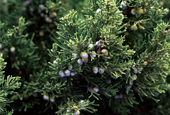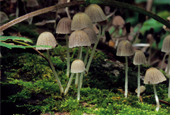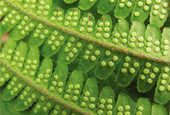View this article in another language
- 한국어
- English
- 日本語
- 中文
- العربية
- Español
- Français
- Deutsch
- Pусский
- Tiếng Việt
- Indonesian
Flora & Fauna of Korea #10
Korea.net publishes a series of articles, “Nature You Meet in the Mountains,” about the peninsula’s mushrooms, insects, trees and herbs & flowers.
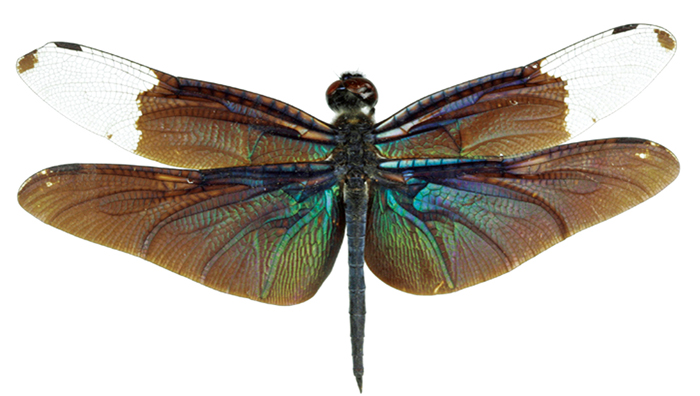
Insects
Name: 나비잠자리 Nabi jamjari
Scientific name: Rhyothemis fuliginosa Selys
Distribution: Korea, China, Japan
This dragonfly, commonly known as a “Flutterer,” has an abdominal length of 22 to 25 millimeters and a wingspan of 34 to 38 millimeters. The head is black. The back of the head and the front tubercle are dark blue. The thorax is black with a glossy dark blue hue, the same for the central and side parts of the thorax. The glossy black abdomen is relatively short and slim. The upper part of the tail is long and slim. The tail has short black feathers. The wings are glossy dark for the most part, but the top edges are transparent, which takes up nearly a quarter of the anterior wings. Dot-like spots are observed on the posterior of the wings. Also, the posterior wings are remarkably wider than the anterior wings. The wing vein is brown and there are black-brown patterns along the edges of the wings. The black legs are short and fragile.
Ecology: Many groups of this dragonfly can be seen flying low from around June to September. After a short mating season, the females spawn alone.
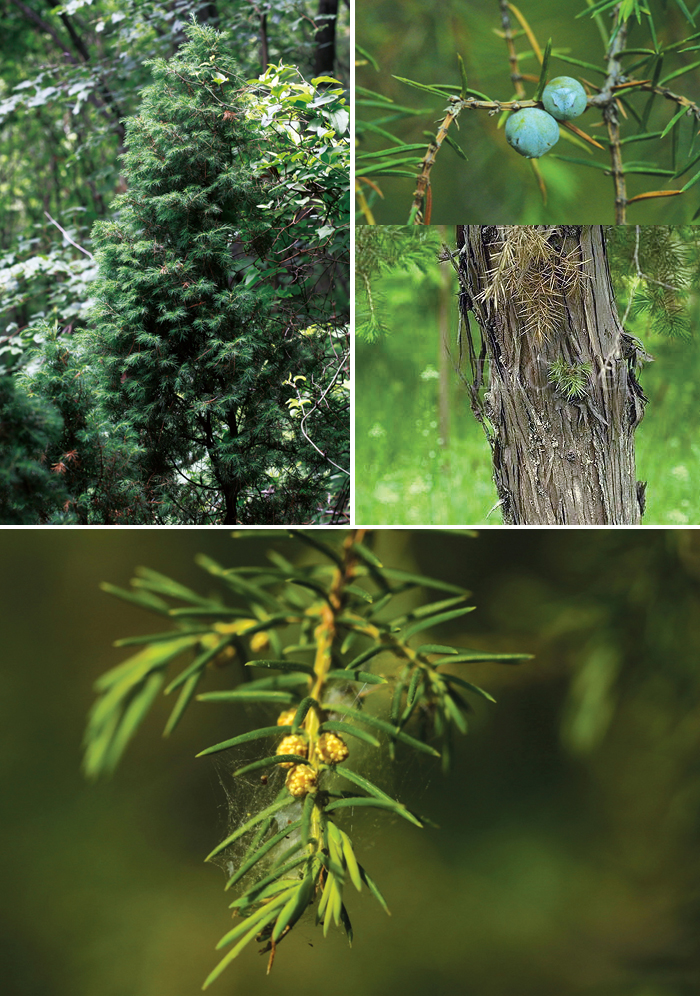
Trees
Name: 노간주나무 Noganjunamu
Scientific name: Juniperus rigida Siebold & Zucc.
Type: coniferous evergreen tree
Blooming season: April to May
Bearing season: October to December
Distribution: mountains nationwide
This juniper grows to a height of eight meters and has a trunk diameter of up to 20 centimeters. It is found mostly in the mountains. The bark is brown and can be cracked lengthwise into long and thin strips. The needles are evergreen and grow in whorls of three. It is dioecious, meaning it has separate flowers for male and female processes, both growing from the axil. The seed cones are spherical and sometimes oval. The seeds are fully mature a year after it turns brown.
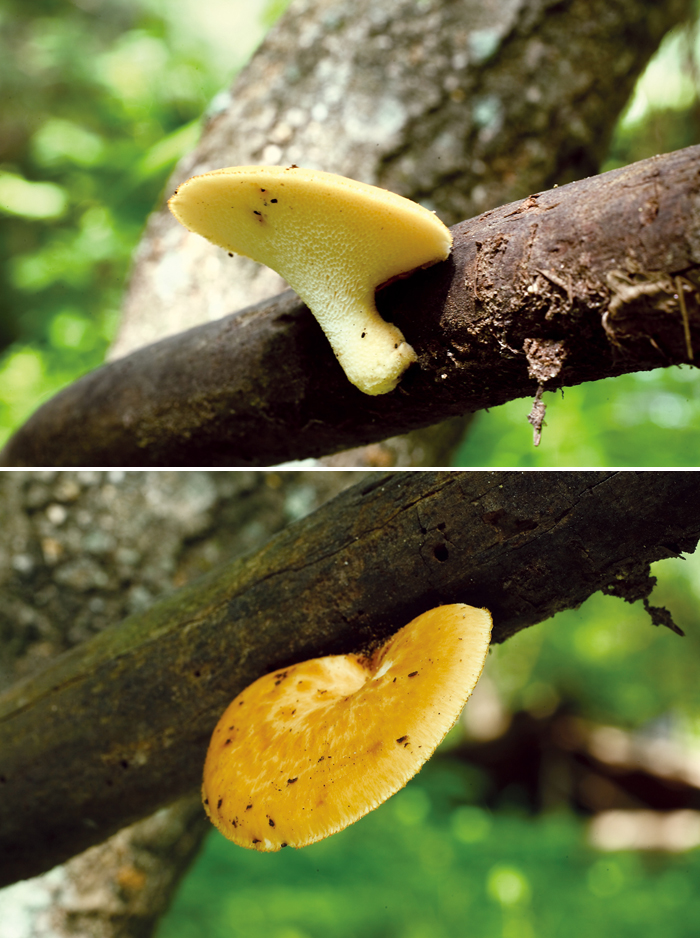
Mushrooms
Name: 구멍장이버섯 Gumeongjangi beoseot
Scientific name: Polyporus squamosus (Huds.) Fr.
Type: saprophile spore
Print: white
Inedible
This mushroom grows from fallen and dead broad-leaved trees, and also from stumps. It causes a white rot in the heartwood. The pileus has an average diameter of 10 to 20 centimeters and is 1 to 3 centimeters thick. It is circular or fan-shaped and the color ranges from yellowish-brown to gray-brown. It has a large dark brown or black-brown squama. Young specimens are soft and toughen with age, when the tissue becomes corky. The pores, found on the underside, have closely-packed tubes that are between 2 to 5 millimeters long. The stalk is thick, short and tough. The roots are dark-brown or black.
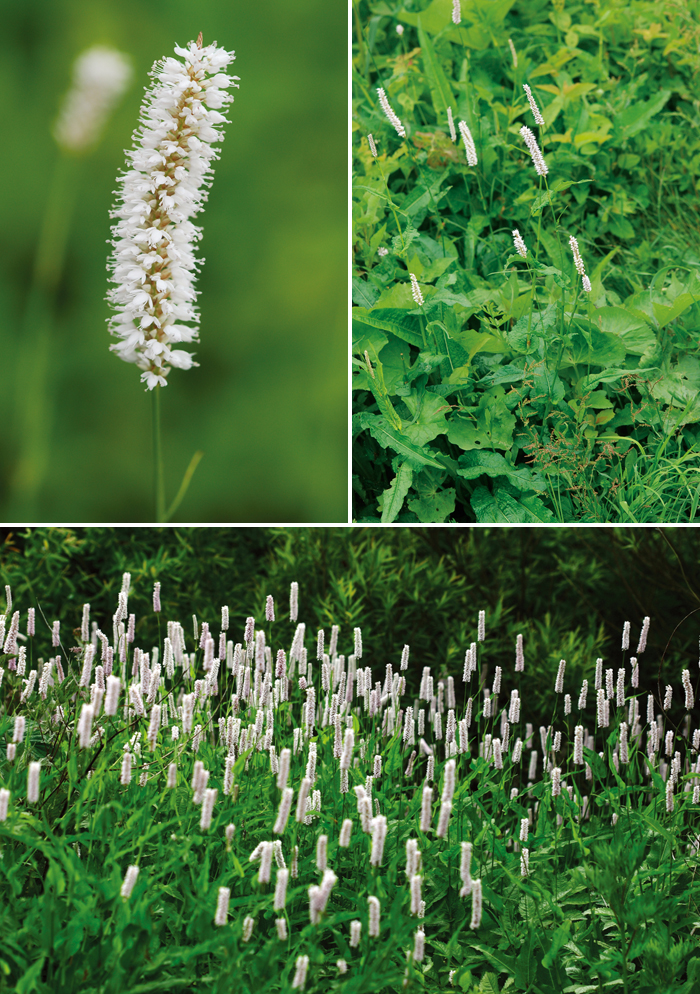
Herbs & Flowers
Name: 범꼬리 Beomkkori
Scientific name: Bistorta manshuriensis (Petrov ex Kom.) Kom.
Blooming season: June to July
Bearing season: September to October
Distribution: mountains nationwide (except Jeju Island)
Known as Asian bistort, this perennial herb grows to a height of 30 to 80 centimeters in the mountains. The subterranean roots are quite thick. The leaves grow from the lower part of the stem in clusters and have white fur on the underside. The leaves growing from the roots alternate between being tall and triangular or lanceolar. The leafstalk later becomes a leaf sheath. The flowers are light pink or white, inflorescent and normally 3 millimeters long. The fruit is an achene, triangular and a bit glossy.
In Korean, it was named after its resemblance to the tail, kkori, of a tiger, beom.
*This series of article about Korea’s insects, trees, mushrooms and herbs & flowers has been made possible with the cooperation of the Korea National Arboretum.
Korea.net publishes a series of articles, “Nature You Meet in the Mountains,” about the peninsula’s mushrooms, insects, trees and herbs & flowers.

Insects
Name: 나비잠자리 Nabi jamjari
Scientific name: Rhyothemis fuliginosa Selys
Distribution: Korea, China, Japan
This dragonfly, commonly known as a “Flutterer,” has an abdominal length of 22 to 25 millimeters and a wingspan of 34 to 38 millimeters. The head is black. The back of the head and the front tubercle are dark blue. The thorax is black with a glossy dark blue hue, the same for the central and side parts of the thorax. The glossy black abdomen is relatively short and slim. The upper part of the tail is long and slim. The tail has short black feathers. The wings are glossy dark for the most part, but the top edges are transparent, which takes up nearly a quarter of the anterior wings. Dot-like spots are observed on the posterior of the wings. Also, the posterior wings are remarkably wider than the anterior wings. The wing vein is brown and there are black-brown patterns along the edges of the wings. The black legs are short and fragile.
Ecology: Many groups of this dragonfly can be seen flying low from around June to September. After a short mating season, the females spawn alone.

Trees
Name: 노간주나무 Noganjunamu
Scientific name: Juniperus rigida Siebold & Zucc.
Type: coniferous evergreen tree
Blooming season: April to May
Bearing season: October to December
Distribution: mountains nationwide
This juniper grows to a height of eight meters and has a trunk diameter of up to 20 centimeters. It is found mostly in the mountains. The bark is brown and can be cracked lengthwise into long and thin strips. The needles are evergreen and grow in whorls of three. It is dioecious, meaning it has separate flowers for male and female processes, both growing from the axil. The seed cones are spherical and sometimes oval. The seeds are fully mature a year after it turns brown.

Mushrooms
Name: 구멍장이버섯 Gumeongjangi beoseot
Scientific name: Polyporus squamosus (Huds.) Fr.
Type: saprophile spore
Print: white
Inedible
This mushroom grows from fallen and dead broad-leaved trees, and also from stumps. It causes a white rot in the heartwood. The pileus has an average diameter of 10 to 20 centimeters and is 1 to 3 centimeters thick. It is circular or fan-shaped and the color ranges from yellowish-brown to gray-brown. It has a large dark brown or black-brown squama. Young specimens are soft and toughen with age, when the tissue becomes corky. The pores, found on the underside, have closely-packed tubes that are between 2 to 5 millimeters long. The stalk is thick, short and tough. The roots are dark-brown or black.

Herbs & Flowers
Name: 범꼬리 Beomkkori
Scientific name: Bistorta manshuriensis (Petrov ex Kom.) Kom.
Blooming season: June to July
Bearing season: September to October
Distribution: mountains nationwide (except Jeju Island)
Known as Asian bistort, this perennial herb grows to a height of 30 to 80 centimeters in the mountains. The subterranean roots are quite thick. The leaves grow from the lower part of the stem in clusters and have white fur on the underside. The leaves growing from the roots alternate between being tall and triangular or lanceolar. The leafstalk later becomes a leaf sheath. The flowers are light pink or white, inflorescent and normally 3 millimeters long. The fruit is an achene, triangular and a bit glossy.
In Korean, it was named after its resemblance to the tail, kkori, of a tiger, beom.
*This series of article about Korea’s insects, trees, mushrooms and herbs & flowers has been made possible with the cooperation of the Korea National Arboretum.
